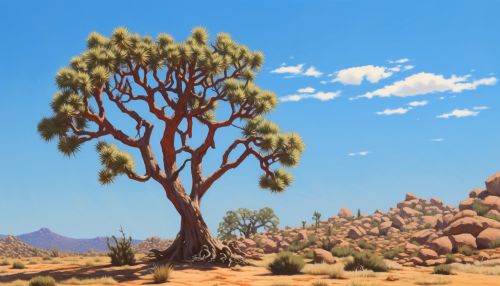Joshua Tree (Yucca brevifolia)
Taxonomy and naming
The Joshua tree, scientifically known as Yucca brevifolia, is a member of the Agavaceae family. The species was first formally described by the botanist George Engelmann in 1871 who named it in honor of its short, broad leaves. The common name "Joshua tree" is said to have originated from a group of 19th-century Mormon settlers who crossed the Mojave Desert and thought the tree's unique shape reminded them of a Biblical story in which Joshua reaches his hands up to the sky in prayer.
Description
Yucca brevifolia is a fast-growing tree that can reach heights of up to 15 meters (49 feet). The tree's bark is rough and fibrous, providing protection against the harsh desert conditions. The leaves are dark green, rigid, and sharp, growing in dense spirals at the ends of the branches. The tree's unique shape, with its irregular branching patterns and dense clusters of leaves, makes it an iconic symbol of the Mojave Desert.


Distribution and habitat
The Joshua tree is endemic to the southwestern United States, specifically the states of California, Arizona, Utah, and Nevada. It is most commonly found in the Mojave Desert, where it thrives in the open grasslands and rocky hillsides. The tree prefers elevations between 1,300 and 1,800 meters (4,300 and 5,900 feet) and is well-adapted to the desert's extreme temperature fluctuations, low rainfall, and poor soil conditions.
Ecology
Yucca brevifolia plays a vital role in the desert ecosystem. It provides shelter and food for a variety of desert animals, including birds, rodents, and insects. The tree's flowers are pollinated by the Yucca moth, in a mutualistic relationship where the moth lays its eggs in the flower, and in return, pollinates the tree. The tree's seeds are dispersed by the wind and by animals that eat the fruit.
Conservation status
The Joshua tree is currently listed as a species of least concern by the International Union for Conservation of Nature (IUCN). However, the tree's population has been declining due to a combination of factors including climate change, wildfires, and human development. Efforts are being made to conserve the species through habitat preservation and reforestation programs.
Cultural significance
The Joshua tree has long held cultural significance for the indigenous peoples of the Mojave Desert, who used the tree's leaves for weaving and the seeds for food. In more recent times, the tree has become a symbol of the American Southwest and has been featured in art, music, and literature. The tree is also a popular tourist attraction, with the Joshua Tree National Park in California attracting over a million visitors each year.
